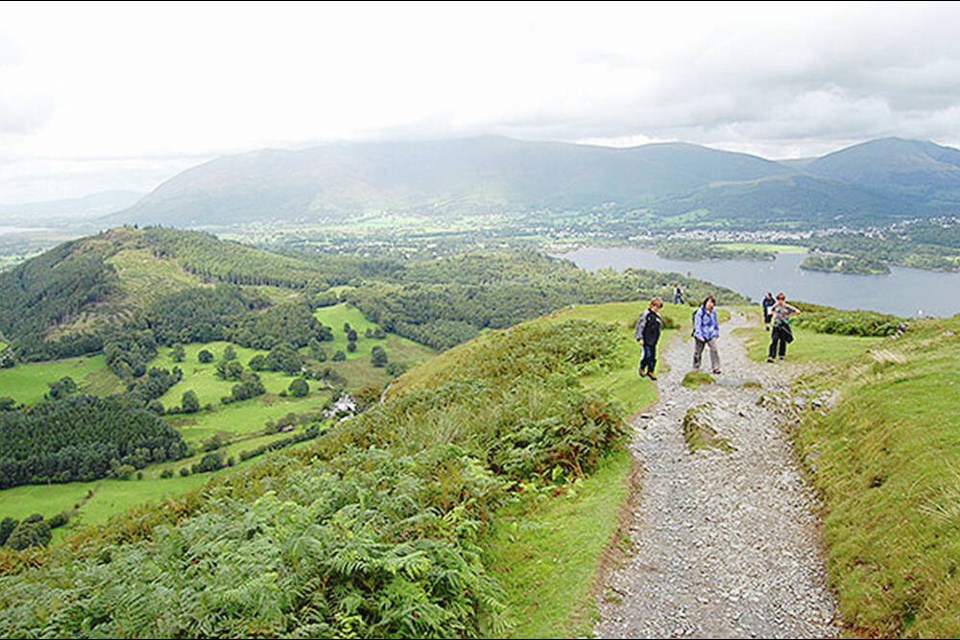For more than a century, North England’s verdant, hilly Lake District has attracted nature lovers. The great poet Wordsworth lived, trekked, and was inspired here. Whether you’re a serious hiker or someone who prefers to ponder panoramas from inside a pub, it’s easy to enjoy the English outdoors in this green landscape of gentle ridges, serene lakes, rock fences, stone bridges, and fluffy sheep.
The district’s southern lakes are handier to London and more promoted, but I like to focus on the northern lakes — Ullswater, Buttermere, and Derwentwater — which are every bit as scenic, with nowhere near the crowds.
The town of Keswick, near Derwentwater Lake, is my favourite home base for the region. It was an important mining centre through the Middle Ages, but slate, copper, and lead gave way to tree-hugging tourists in the 19th century.
One of the area’s most photographed and popular lakes, Derwentwater, has four islands, good boat service, and plenty of trails. Cruises run around the lake and to trailheads — including the one to Catbells, a 1,480-foot hill above Derwentwater.
One summer, I finally struggled up and over Catbells — a walk I’d recommended for years (and felt guilty for having never actually hiked in its entirety). The weather almost kept me in. But I was glad I ventured out — I welcomed the wind “blowing the cobwebs out” (as my B&B host warned) atop the hill, the comedic baaing of sheep, and being “the stick figure on the ridge” for those observing from distant farms or boats on the lake … as others have been the stick figures for me.
The hike confirmed the soundness of the advice I’d long heard about Britain’s weather: Don’t wait for it to get better. Blustery winds and wet skies are part of the scene; consider them a blessing. The majority of “bad weather” comes with broken spells of brightness. As they say here, there’s no bad weather … just inappropriate clothing. And if you’re in a hiking area and your clothing is inappropriate, your B&B host can likely loan you a heavy coat (along with the best local map).
And, oh, the joy of a pub after a good hike. Studying the light on ruddy faces while sipping the local brew has always been part of the magic of travel in Britain. When your face is weather-stung and your legs ache happily with accomplishment, a pub’s ambience sparkles even brighter.
When you’re done hiking, Keswick is a delight for wandering. The town’s centrepiece, Moot Hall (meaning “meeting hall”), was a 16th-century copper warehouse. Graphite was first discovered here centuries ago. A hunk of the stuff proved great for marking sheep in the 15th century. In 1832, the first crude Keswick pencil factory opened; today you can learn its history at the Derwent Pencil Museum.
If you visit, you’ll discover that English holiday-makers take their dogs with them on vacation. The town square can look like the Westminster Dog Show, and the Dog and Gun pub, where “well-behaved dogs are welcomed,” is always full of patient pups. If you are shy about connecting with people, pal up to an English pooch — you’ll often find they’re happy to introduce you to their owners.
About five kilometres east of Keswick, there’s a mini-Stonehenge drenched in Lake District beauty: the Castlerigg Stone Circle. For some reason, 70 per cent of England’s stone circles are here in the northern region of Cumbria. Castlerigg is one of the best and oldest in Britain, and an easy stop for drivers. The circle — 27 metres across and 5,000 years old — has 38 stones mysteriously laid out on a line between the two tallest peaks on the horizon. They served as a celestial calendar for ritual celebrations.
I like to imagine this setting when ancient people filled the clearing in spring to celebrate fertility, in late summer to commemorate the harvest, and in the winter to mark the winter solstice and the coming renewal of light. Festival dates were dictated by how the sun rose and set in relation to the stones. The more that modern academics study this circle, the more meaning they find in the placement of the stones. For maximum “goose pimples” — as they say in England — be here at sunset.
The Lake District is a land where humanity takes a few steps back and looks on as nature rules. The weather, like a dark army, storms overhead. Hiking along a ridge, buffeted by wind, and marvelling at the commanding, 360-degree view makes me feel small, yet ready to take on the world.
This article is used with the permission of . Rick Steves writes European guidebooks, hosts travel shows on public TV and radio, and organizes European tours.



